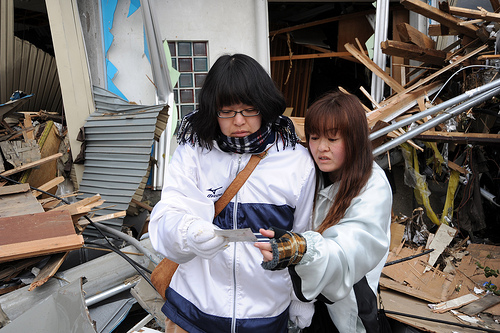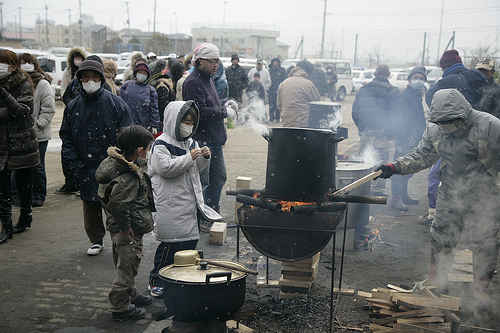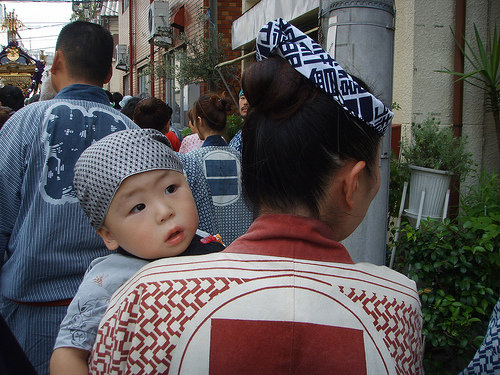As parents from Fukushima prefecture line up in Tokyo for public protests and a more recent 7.0 level earthquake hit off shore of the east coast of Honshu, Japan on July 9, the latest data on nuclear power reveals: the amount of radiation inside the plant's reactor has reached much higher than originally expected levels. Current released figures through JAIN - Japan Atomic Industrial Forum show 4,000 millisieverts per hour of radiation on June 4 was measured in Reactor No. 1 through a steam release rising from a crevice in the floor.
But what do the figures mean? And what does it mean for mothers and women who are pregnant in regions that are highly impacted by six damaged nuclear reactors with three complete core melt-down failures at the Fukushima plant?
According to the Japan's Nuclear Safety Commission the total release of radioactive iodine-131 to date is now equal to 630,000 terabecquerels, a figure that has caused numerous public and private safety concerns in Japan.
Parents along Japan's eastern region are now facing increased worries about their children, especially the youngest members of the family.
Some mothers who feel they have been exposed to levels of radiation that could cause their breast milk to be compromised are also making decisions away from breast feeding their infants. Even the possibility of compromised powdered milk, used to feed infants, is being scrutinized.
Current radiation release figures from TEPCO, the power company that operates and manages the Fukushima Daiichi nuclear power plant now reveals that larger than originally reported releases of radiation at 770,000 terabecquerels did happen, a level that may hold much more significance as the disabled plant is expected to continue to release radioactive isotopes over an extended period of time.
"The situation at the Fukushima Daiichi plant remains very serious," said the IAEA - International Atomic Energy Agency in a recent March 26, 2011 report.
Those with specific rising concerns include a subgroup of people who have followed the changing atmosphere of reports from TEPCO - Japanese women who are either pregnant or already mothers who now have worries about their children.
As the CDC - Centers for Disease Control and Prevention informs, "large radiation doses to the fetus during the more sensitive stages of development, between weeks 2 and 18 of pregnancy, can cause birth defects, especially to the brain."
But the outcome is not always set in stone. "Between the 18th week of pregnancy and birth, radiation-induced health effects (besides cancer) are unlikely unless the fetus receives an extremely large dose of radiation," continues the CDC.
"From a dose of 100 microsieverts (mSv) on, there is assumed an increase of cancer-rate. Even the unborn life can be damaged and, accordingly, the small children can get cancer or leukaemia," explains Christina Hacker, radiation expert at the Munich Environment Institute. "250 mSv is the threshold-dose for beginning radiation effects in the blood, to the unborn life it can take harm to the retardation of the brain," Hacker explains.
Despite a report that 340 times the usual background level of radiation exists at the plant, the Japanese Broadcasting Network - NHK says, many experts in radiation assure that there is nothing to worry about as long the safety measures are respected.
Anti-nuclear protesters in Japan and across the globe argue these facts as the recently July 9 evacuated plant's level of radiation is continuing to be a rising source of long range danger. Other experts beg to differ.
"We can have a CT scan and we don't think twice about it," says Professor Gerry Thomas, a radiation and cancer expert at Imperial College in London who has studied the Chernobyl case for 20 years. "We live in a radioactive world. We are prepared and adapted to live in radiation," Professor Thomas says.
Highest radiation levels recorded in Fukushima plant were 400 mSv per hour in mid March. The latest reports from Japanese national broadcaster NHK inform us that in Fukushima city alone, 65 kilometers (37 miles) northwest of the nuclear plant, radiation levels have been measured at 13.9 mSv per hour.
In the wake of the ongoing disaster, Japan's parliament is also paying close attention to the needs of the workers at TEPCO - Tokyo Electric Power Company, the company who operates and manages the plant. Financial compensation for those who have been exposed to levels of radiation that are higher than originally estimated is also being discussed.

Many people are suspicious, however; especially when another little person is growing inside. Some pregnant women in Japan are particularly alarmed, while others try to ignore their radiation worries.
Either good or bad the real questions are: How much radiation is too much and where is the limit that goes from natural to damaging?
To understand the answers, figures should be compared and taken in perspective. As a reference, according to the World Nuclear Association, here are some of the basic facts:
In medical treatments, 0.1 is the quantity of mSv in a chest X-Ray, 0.4 in a mammogram X-Ray and 10 is the dose in a full body CT scan. Regarding other common sources, 2 mSv per year is the typical background radiation experienced by everyone, with an average 1.5 mSv in Australia and 3 mSv in North America. 9 mSv per year is the level exposure by airline crew flying the New York to Tokyo polar flight route.
The key is this: Accumulation does count.
For every radiation accumulation of 1,000 mSv in the body of the average person, an increase in the probability of having a fatal cancer many years later rises by 5 percent. But if 1,000 mSv are taken in a single dose it can cause radiation sickness such as nausea and decreased white blood cell count.
A 5,000 mSv single dose of radiation would kill about half those receiving it within a month. 6,000 mSv, is the reported dose that killed Chernobyl workers within a month.
Numerous Japanese mothers and pregnant women are worried that food radiation levels may also be increasing. A Centre for Food Safety survey of foods contaminated with radioactive cesium and iodine have shown increased levels in regions as far as 360 km (224 miles) away from the Fukushima plant. Foods with some form of radioactive isotope contamination include many of Japan's largest export foods, including algae, seafood, milk, green tea, mushrooms, spinach, bamboo shoots and plums.
Tap water has also not been saved from exposure. On July 4 trace levels of the dangerous radioactive isotope cesium 137 were also found in City of Tokyo tap water for the first time since April. These trace levels were, however, beneath the official levels outlined by the government safety regulations as harmful.
But pregnant women and infants may still be in a heightened position of danger from exposure. Levels of tap water radiation were measured at twice the allowed level for infants on March 22 causing Tokyo officials to ask all mothers to give their babies bottled water to drink instead of tap water. The following day, radiation levels in the public water supply dropped to allowed levels.
If levels of radiation are too low to make an expectant mother sick, they can still cause harm to the fetus says the Center for Disease Control and Prevention (CDC), even though the mother's abdomen does shield the baby and protect it from some radioactive sources outside the womb.
During the first two weeks of pregnancy, radiation exposure can prove to be fatal for a baby if specific levels are reached. Specific levels of exposure to radiation for a fetus can cause deformities, stunted growth, abnormal brain function or even cancer at some later point in life, says the CDC.
During weeks 2 and 18 of a pregnancy, too much radiation exposure can cause severe health consequences, especially to the brain. But the level of the dose would have to be higher than a dose equaling 500 chest x-rays.
Exposure is relative
When it comes to radiation time, distance and levels, single dose or accumulative dose does matter. There are many factors that might affect the risks that radiation can have to our health; especially for pregnant women.
It is important to know how women can protect themselves and their babies.
"It depends on the time exposed to that radiation. In Fukushima it is 400 msv per hour, whereas the people who died at Chernobyl had 4000 msv or more," explains author and nuclear medical physicist Professor Wade Allison, at the University of Oxford. "So, if somebody stays there for 10 hours they are in big, big trouble, because that would mean 4000 msv in total for 10 hours. But if they are they for 1 hour then, it's not a good idea."
"The important thing to realize is that radiation goes away very quickly," argues Professor Thomas; "so if you are right next to the source, exposure will be higher, but if you are 100 meters away you will get it much, much lower. It decreases very rapidly."
Radiation levels between a 20 km (12 miles) and 60 km (37 miles) distance from the Fukushima nuclear plant are declining or are stable said the World Health Organization (WHO) last April; before recent higher figures were released to the public. "Levels are still above historic background levels in most prefectures but are low in terms of human health risk" said the WHO in April.

"It is very easy to protect yourself against radiation. In the sense of the population at large the Japanese Government did exactly the right thing," considers Professor Thomas. "They learned all the lessons from Chernobyl and they knew exactly what it was supposed to do."
"You move away from the source; you limit the amount you breath in by shutting the windows and the doors, which is what they advice to do so you don't bring the air in; don't hang the washing outside and bring the washing in because that would bring contamination into the house," explains Thomas.
Cesium 137 which is being released by the plant has a half-life of 30 years and can enter through contaminated air, food or water causing nausea, vomiting, bleeding, diarrhea, coma and even prove fatal in some extreme cases. Iodine-131, another radioactive chemical being released, is known to cause thyroid cancer.
"The goal is to limit the dose to the fetus to less than 5 millisieverts (mSv) during gestation from ingested food, water and external exposure. The Japanese government has moved the population out of heavily contaminated areas to limit the external exposure of individuals," says Kathryn Higley, Head of The Department of Nuclear Engineering and Radiation Health and Physics at Oregon State University.
Swift evacuation for areas surrounding a nuclear core melt-down is essential for safety along with restrictions for others to stay inside. As dangers to the plant began to rise over 80,000 people were evacuated from the area surrounding the Fukushima Daiichi power plant following March 11.
"The standards set in the US and Japan for consumption of food that contains measurable amounts of radioactive material were set to limit the dose to women and infants to acceptable levels," says Higley. "...officials [in Japan] are measuring the radionuclide concentration and determining what foodstuffs are safe for consumption by all members of the population."
"We prefer not to think about it"
Professor Thomas states it clearly: "I wouldn't worry if I was pregnant in Japan." However, feelings might change when it is you who is expecting a baby.
Hiroko [not her real name] and her husband live in Kyoto, about 700 km (approx 435 miles) away from Fukushima. Hiroko who was pregnant since August 2010 was due to have her baby in May.
The couple did not seem especially worried about the dangers but, at the same time, they acknowledged that they prefer not to watch too much television and not to think too much about radiation.
"Obviously it is worrying but, in this sense, what we think is that the further away we are from the problem, the better." While Hiroko was pregnant they were not given any special instructions regarding radiation exposures.
"If we have to choose, we prefer to believe the positive version," they said.
"Parents will always worry, thanks Goodness," says Professor Allison from Oxford. "It's important that children are looked after, just as children should be kept away from fire and they should have the right number of clothes on... but radiation is not a special problem now."
Lately, the severity rating of the Fukushima nuclear crisis have been raised to level 7, the highest possible. With this rating, the Japanese plant is more often being compared with nuclear the nuclear disaster at Chernobyl, which was also a level 7.
The main fear of radiation is that many of its consequences are seen in to be damaging in the long-term. In this sense, it is difficult to forget the risks and maybe, as Hiroko does, the best thing to do is "not to think about it."
Fukushima isn't finished yet. The question is: Will there ever be a real end to this current disaster?
An updated report from Amy Goodman and Democracy Now! interviews two experts about the Japanese nuclear crisis including Aileen Mioko Smith of Green Action and Robert Alvarez, former senior policy adviser to the U.S. Secretary of Energy about the latest on elevated levels of radiation in affected areas surrounding the Fukushima Daiichi nuclear power plant. Mioko Smith also outlines additional dangers to pregnant women and young children from the effects of unsafe levels of radiation, citing a need for additional evaluations. Japan's Nuclear and Industrial Safety Agency recently admitted for the first time that full nuclear meltdowns did occur at three of the plant's reactors, as it more than doubled its estimate for the amount of radiation that leaked from the plant in the first week of the disaster in March. For the transcript, podcast and more Democracy Now! reports about the Japan disaster, visit http://www.democracynow.org/2011/6/10/as_japan_nuclear_crisis_worsens_citizen This 15 minute June 10, 2011 video is a production of Democracy Now!
Nuclear activist, author and expert Dr. Helen Caldicott speaks frankly about the dangers of radiation and the Fukishima disaster at a Centre for Globalization Research press conference in Montreal, Canada on March 25, 2011. Caldicott co-founded and was President of the Physicians for Social Responsibility (PSR) in the United States. Caldicott also supported the founding of IPPNW - International Physicians for the Prevention of Nuclear War and founded the Women's Action for Nuclear Disarmament (WAND). Receiving many awards for her work, including 19 honourary doctorates and the Gandhi Prize she was nominated for the Nobel Peace Prize by Nobel Peace Laureate Linus Pauling. Caldicott is also a recent laureate of the Nuclear-Free Future Award 2011. This 10 minute video is a production of www.GlobalResearchTV.com.




Comment: The reader should keep in mind that the government and MSM have been downplaying the effects of radiation on people since this event began.
Read these articles for more information:
Radiation Protection: Your Child and Your Pregnancy...
Japan Radiation Survey Shows 1 In 20 Fukushima Children Will Develop Thyroid Cancer
There is no 'safe' exposure to radiation